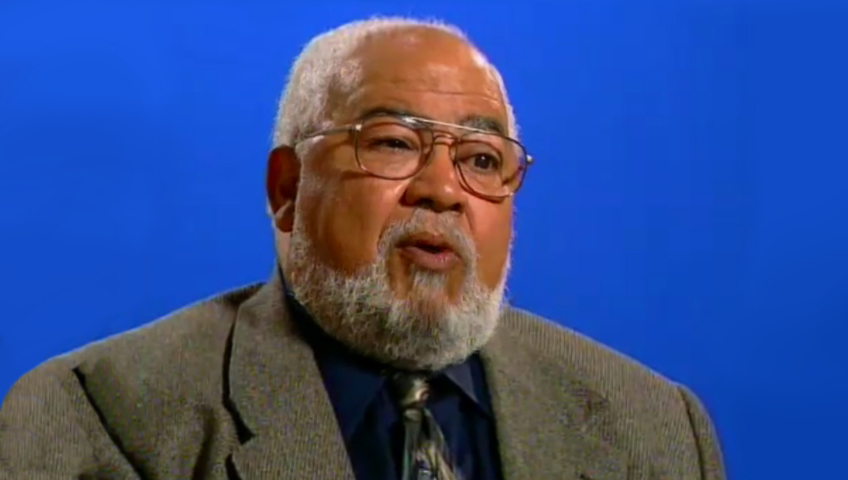Pioneer as Artist, Reporter at Courier Journal
Support Journal-ismsDonations are tax-deductible.
This original one-on-one interview with Merv Aubespin, part of the Civil Rights Movement in Kentucky Oral History Project, was produced by the Kentucky Oral History Commission and Historical Society (video).
Pioneer Artist, Reporter at Courier Journal
The late Unity: Journalists of Color, a coalition of the Black, Hispanic, Asian American and Native American journalist organizations, was miffed that New York University’s 2012 list of the top journalists of the last century was short on people who looked like them.
So they put together their own — a “seed list”– and of course Mervin Aubespin was on it.
Why? When “Uncle Merv” was inducted in 2007 into the National Association of Black Journalists’ Hall of Fame, NABJ summed up his career thus:
“Merv Aubespin: Past president of NABJ from 1983-1985. He established the organization’s first national office and increased the visibility of NABJ internationally.
“For 34 years, he worked as an artist, reporter and editor at the The Courier-Journal in Louisville, Kentucky and has served as an advisor to newspaper executives seeking to recruit and retain journalists of color.
“Thousands of professional and aspiring journalists across the country affectionately refer to Aubespin as
‘Uncle Merv’ as he remains a popular mentor and lecturer.”
‘Uncle Merv’ Aubespin died at 86 Wednesday and had been living in Southern California, Rachel Smith reported for the Courier Journal. The story did not list a cause of death, but Aubespin’s friend and Louisville colleague, Betty Baye, told Journal-isms June 27 that the cause was colon cancer and that Aubespin died at his home in Rancho Mirage, Calif.
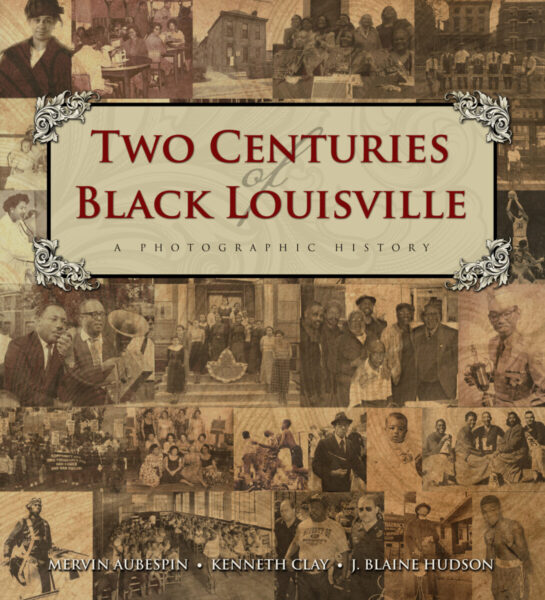
Scott Coffman wrote in a review for the Louisville Courier Journal, ” . . . I am uncustomarily speechless at the sheer beauty of this volume. The muted colors throughout seem to mirror the lives portrayed, a sad darkness in the dispirited lives created by the slave trade. The rich sepias and ochers, however, burst from the page like the pride and promise so evident in the faces of those captured by the photographer’s lens.”
It was true, as Smith wrote, that Aubespin was a pioneer in Louisville. As Wayne Dawkins reported in “Black Journalists: The NABJ Story,” in 1965, “The Courier-Journal in Louisville, Ky., hired Aubespin. He was the paper’s first black artist.”
When riots erupted in Louisville’s Black community, Aubespin’s white colleague was sent back to the newsroom because of safety concerns, and Aubespin was asked to assume the role of reporter, which he continued for many years, according to a Courier-Journal account.
In 1972, Aubespin spent a summer at Columbia University for a crash course on news reporting.
He rose to associate editor. “As a reporter and later editor at The Courier-Journal, Aubespin covered the civil rights movement and led a team that wrote the award winning [40-story] 1981 series about being black in Louisville,” Keith L. Runyon, former editorial page editor, his colleague and good friend, would write.
Before joining the newspaper, Aubespin, a Louisiana native, was active in local civil rights demonstrations for public accommodations in 1961. He worked with Martin Luther King Jr. during the bus boycott in Montgomery, Ala., and participated in the storied Selma to Montgomery March in 1965.
He used some of that knowledge to co-author 2011’s “Two Centuries of Black Louisville: A Photographic History.”
But as the late David Hawpe, another friend and colleague of 35 years, would say, “Uncle Merv” was better known nationally than he was locally.
He founded NABJ’s first local chapter — in Louisville. Such organizations as the former American Copy Editors Society award scholarships in his name. He NABJ from 300 members to more than 1,000 and helped establish the association’s national office in Washington, D.C. (Membership is now triple that.)
Aubespin led journalists in 1985 on a report on drought in West Africa and has been a consultant on United Nations development programs. He has also been a member of the United Nations Task Force on AIDS in Africa.
The late Michel Marriott, who profiled Aubespin in 2000 for NABJ’s 25th-anniversary project on NABJ’s presidents, “Committed to the Cause” [PDF], elaborates:
“Not surprisingly, a hallmark of Aubespin’s term as NABJ president (beginning with a narrow election victory over a highly favored candidate [Acel Moore]) was significantly raising the profile of the organization, while greatly expanding its membership while lending it a more prominent presence in national and international arenas. In a sense, NABJ became truly progressive under Aubespin’s guidance and careful consensus building.
“In short order, Aubespin established the organization’s first national office. It was housed in a modest space in the building that was home to The Courier-Journal, the regional newspaper based in Louisville for which Aubespin worked more than 30 years as an artist (long ago he had designed NABJ’s familiar logo), reporter and administrator. He even hired a part-time secretary to do clerical work and answer NABJ’s telephone, simple yet essential tasks for an organization being transformed from a relatively small, insular group into a large, professional one.
“To further mark and ensure that transformation, Aubespin worked with NABJ’s new treasurer, Thomas Morgan III, to hire the organization’s first financial auditor. He stepped up publication of the NABJ Journal, turning it into a quarterly. He also traveled 100,000 miles, visiting, as he said, ‘every chapter I could and going everywhere I was invited.’
View this post on Instagram
“The founder and twice-president of the Louisville Association of Black Communicators was, as he is still fond of saying, creating NABJ ‘family.’
“To this day thousands of young journalists affectionately refer to the gregarious, bespectacled man with a friendly round face and silver hair as ‘Uncle Merv.’ He remains a popular mentor and college lecturer.
“Almost right away, and not without controversy, Aubespin began forging visible alliances between NABJ and the organizational and corporate leadership of mainstream media. All the while he tried to allay fears of members troubled that NABJ, which was largely founded to challenge white media to open its newsrooms and boardrooms to black journalists, might be getting too cozy with those better kept at arm’s length.
“His strategy, he recalled recently, was sound: ‘I wanted to get white media leadership to involve itself in NABJ so it could establish some relationships and we could all be less confrontational.’
“As a result, he said, ‘For the first time white editors and news directors and white media leadership — with their financial resources — came together with NABJ and its mission.’ Supporters and critics agree that NABJ was forever changed by the infusion of white media interests and money.”
“When Aubespin was named the 2010 recipient of Louisville’s Dr. Martin Luther King Jr. Freedom Award, he invoked the spirit of the civil rights icon.
“I am honored that the city has chosen to recognize me for my efforts at making a difference,” Aubespin said. “I am particularly mindful that the award is named after Dr. King, who had a considerable impact on my life and the lives of so many others. During many conversations with Dr. King, one thing became clear — that change is made when people decide to get involved. I trust that I have lived up to that example.”
- Wayne Dawkins, Black Alumni Network/LinkedIn: Mervin Aubespin, directed NABJ growth age (July 1)
- National Association of Black Journalists: NABJ Mourns the Loss of Mervin Aubespin, Past President 1983-85
From Social Media
Those of us who were around when ACES: The Society for Editing got its start as the American Copy Editors Society remember how important Merv’s support and wisdom were, as reflected in the scholarship named for him. May he rest in peace, gratefully remembered.
Vince Rinehart
Retired copy editor
Washington Post
I join journalists across the country in mourning the death of Merv Aubespin, a civil rights activist and pioneering Black journalist, whose moral compass was always set to the North Star. I had the pleasure of working with him through the National Association of Black Journalists and American Society of Newspaper Editors, and he once helped me run a multicultural high school journalism program at San Francisco State University. Thanks to Richard Prince’s Journal-isms for this coverage about “Uncle Merv.”
Jon Funabiki
Emeritus professor of journalism, San Francisco State University
So, when I was in college, I never really had the money to go to NABJ conventions or SPJ or IRE or any of the journalists conventions.
But I knew I needed to be there, because that’s where the jobs were and the people I needed to meet to get jobs. So I would go to the conventions but not register. I would sit in the bar area and try to meet people, or try to find a way into the job fairs by hook or by crook.
Every single time Merv Aubespin would see me and Rodney Crouther hanging around the lobby, he’d buy us lunch or dinner. He knew we were two college students on a shoestring, sharing the cheapest hotel rooms, and scrimping on expenses. So he’d always treat when he saw us.
He never lectured or turned us in to convention officials, in fact, he told us that he was impressed with our drive to become journalists. It’s in his name I work with students, and I hope that one day someone will be able to look at me like I look at him, as someone who made sure a struggling college journalist had at least a helping hand.
Rest in power, Uncle Merv.
Jesse J. Holland
George Washington University
‘The South Got Something to Say’
June 23, 2024
Atlanta Journal-Constitution Documents Hip-Hop
H.L. Gates Jr.: Why Popular Juneteenth Story Strains Credulity
Willie Mays Case Awakened Press to Bias in Housing
Stephen A. Smith Reportedly Seeking $25M a Year
Yahoo Writer Casts Doubt on Jordan’s Record
Vega Reports on Alleged Saudi Complicity in 9/11
Station Live for 24 Hours From Detroit Neighborhood
Rose Tibayan, TV Journalist, Mentor Dies at 64
Journalists Pushed Into Exile in Record Numbers
Migrants Now Smuggled Via Pricey Charter Flights
Why ‘Minority’ Doesn’t Work for David Oyelowo
Short Takes: Washington Post; Arizona State’s Center for Culture and Inclusion in Media; Nathan Hare; Mary Hudetz; folding of St. Croix newspaper; Sheila Solomon; Lee Hawkins; Kevin Merida; three who started in the Black press; “Our America: In the Black” from ABC Owned Television Stations; censorship in Guinea; defamation sentences reintroduced in Niger; suspending broadcasts in Burkina Faso; Sudan detains television journalist.
’40 Acres and a Lie,’ Matt Murray, Mentoring Black Male Journalism Students Are July 1 Journal-isms Roundtable Topics
Support Journal-ismsDonations are tax-deductible.
Atlanta Journal-Constitution Documents Hip-Hop
David Oyelowo, the British actor of Nigerian descent, was marveling last week about African Americans.
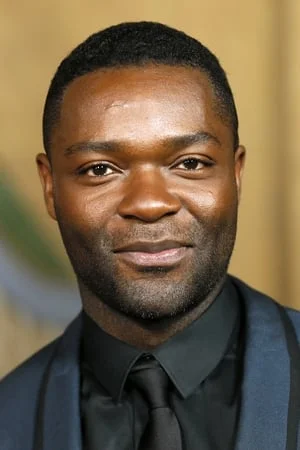 Oyelowo (pictured) plays the title character in a streaming series about Bass Reeves, the formerly enslaved man who went on to become one of America’s first Black deputy U.S. marshals. Oyelowo rose to prominence playing Martin Luther King Jr. in Ava DuVernay’s 2014 film “Selma.”
Oyelowo (pictured) plays the title character in a streaming series about Bass Reeves, the formerly enslaved man who went on to become one of America’s first Black deputy U.S. marshals. Oyelowo rose to prominence playing Martin Luther King Jr. in Ava DuVernay’s 2014 film “Selma.”
“The thing that I have come to learn and truly appreciate, which I will fully admit I didn’t before, is just how extraordinary Black people in America are,” Oyelowo told Tonya Mosley on public radio’s “Fresh Air.”
“And I mean that in terms of African Americans. When you look at just how much injustice, how much challenge, how much pain, how much — how many lies have also been told about the reality of who and what Black people are to this country. Black people built this country. There is no America without the stealing of all of those Black bodies to basically build this nation. There just isn’t. And for all of that injustice to be foisted upon a people, and then to still be invested in building the country, building community, taking ownership of being American, is truly extraordinary to me.”
Oyelowo’s words are seconded in a new documentary about the rise and prominence of hip-hop, “The South Got Something to Say,” produced by the Atlanta Journal-Constitution and screened Thursday in Washington, D.C., its first showing outside of Atlanta.
The film is a showcase for that city and for the art form and culture exported by those whom Sen. Raphael G. Warnock, D-Ga., called “urban griots.” It is also one example of how news organizations can reinvent themselves by finding new audiences in innovative ways.
“South Got Something to Say” — the words were a “defiant clarion call” in an acceptance speech by Atlantan André 3000 of OutKast at the 1995 Source Awards (video) — is the work of Black journalists at the Journal-Constitution.
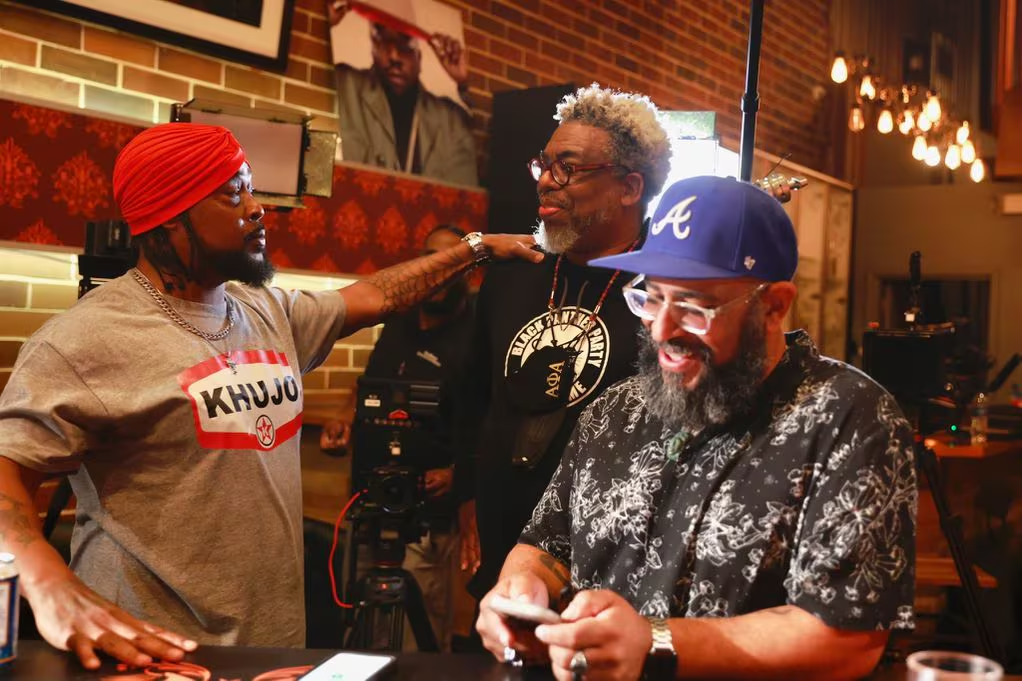
Khujo Goodie of the group Goodie Mob, left, with AJC reporter Ernie Suggs and AJC filmmaker Tyson Horne. (Credit: Natrice Miller)
The principals are enterprise reporter Ernie Suggs, cultural reporter DeAsia Paige, multimedia journalist Tyson Horne, visual journalist Ryon Horne, and Byron Horne. The latter three own an independent film company called the Horne Brothers.
The AJC is now led by its first Black editor, Leroy Chapman Jr., and by publisher Andrew Morse, a former executive vice president of CNN US who has said he is determined to transform the AJC “from a storied daily newspaper into a modern media company.” Morse is aiming for 500,000 digital subscribers largely across the Southeast by the end of 2026, up from about 60,000 in 2023, The Wall Street Journal has reported.
“South Got Something to Say” was completed last year in just six months. On Tuesday, the AJC announced the launch of another Black project: UATL, “a new and definitive source for Atlanta Black culture, brought to life through stories, videos, events, experiences, partnerships and more.
“Atlanta is the center of modern Black culture, nourished by a collection of HBCUs, groundbreaking Black entrepreneurs and political leaders, thriving music, food and fashion scenes and a legacy of civil rights advocacy,” the news organization said. “UATL will put Atlanta’s Black experience into context through the lens of experienced journalists and contributors.”
The D.C. screening was held Thursday at the Martin Luther King Jr. Memorial Library before an audience raised on the hip-hop that last year celebrated its 50th anniversary. Smiling attendees recited the words of the songs along with the artists and nodded with approval.
The Atlantans declared that while the hip-hop might have started in the South Bronx, and the “beefs” that dominated much of the hip-hop conversation involved New York and the West Coast, so much of the hip-hop scene now originates in their city.
The film doubles as a primer for those with only passing knowledge of the genre. Included are Atlanta’s first rapper, known as “Mojo”; producers Jermaine Dupri, Dallas Austin and Zaytoven, and such artists as Killer Mike, Goodie Mob, Speech, T.I., the Dungeon Family, Lil Yachty, Young Jeezy, Silk Tymes Leather and Baby Tate.
Atlanta’s Black community — from its working-class fashionistas to its elected officials — is the star, too. Former mayors Andrew Young, Maynard Jackson, Kasim Reed and Keisha Lance Bottoms and current mayor Andre Dickens contribute their thoughts. A photo shows Dickens, who is 50, in the hip-hop group he joined in high school.
Giving credence to the spirit of Oyelowo‘s observation, the trailer begins, “”Hip-hop is a product of Black people. It’s a product of Black song, a celebration.””
In the film, Bottoms recalls how, during the nationwide protests in 2020 over the police killing of George Floyd, she called in Killer Mike to speak to Atlanta’s young people. “I watched a white officer assassinate a Black man, and I know that tore your heart out, and I know it’s crippling,” Killer Mike, born Michael Render, said at the mayor’s news conference.
“That’s why children are burning [things] to the ground, they don’t know what else to do,” he continued. “I am duty-bound to be here to simply say: That it is your duty not to burn your own house down for anger with an enemy.”
In 2018, Bottoms put Killer Mike and T.I. on her transition team.
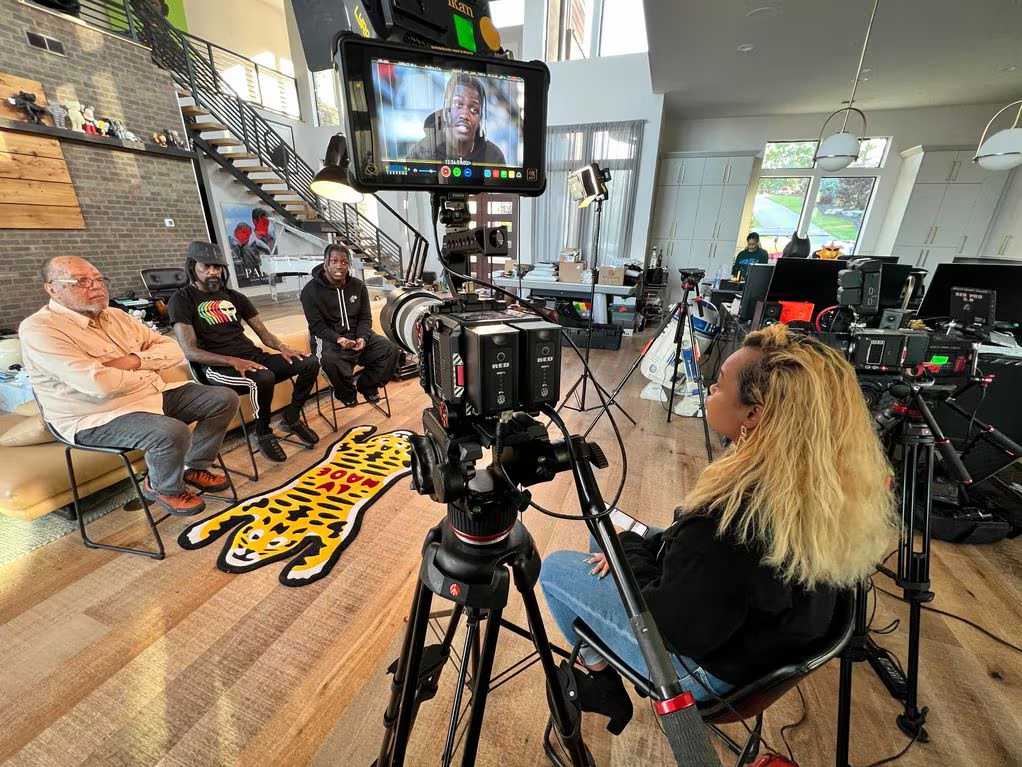
DeAsia Paige interviewing Philip McCollum, Shannon McCollum and Lil Yachty for “The South Got Something to Say” documentary. (Credit: DeAsia Sutgrey)
 There is no forgetting that this is the work of journalists. Sonia Murray (pictured). who took a buyout in 2009, recalls how she became a hip-hop reporter in the 1990s after asking why the paper wasn’t “writing about new, young, local acts like TLC, Kris Kross and Arrested Development,” she told the AJC during hip-hop’s 50th anniversary.
There is no forgetting that this is the work of journalists. Sonia Murray (pictured). who took a buyout in 2009, recalls how she became a hip-hop reporter in the 1990s after asking why the paper wasn’t “writing about new, young, local acts like TLC, Kris Kross and Arrested Development,” she told the AJC during hip-hop’s 50th anniversary.
The journalists explained to the audience, and Suggs later told Journal-isms, “While this was a movie, we are still a newspaper and had to operate as such.
“Which meant that everything was on the record and no interviews were paid for. On at least one occasion, I made contact with a rapper, whom we hadn’t heard from in years, and asked about his participation. He asked how much, and I told him we couldn’t pay. He hung up. I called him back and got voicemail. All of his contemporaries ended up in the film and while we didn’t pay them (we did pay for the rights to their music) they have all benefited from the exposure.”
While the film documented Atlanta’s role as a prime exporter of hip-hop, its creators did address its shortcomings. DeAsia Paige said at a panel after the D.C. screening that “We need to treat women and queer people better within the genre.”
Journal-isms asked Tyson A. Horne what he thought of media coverage of hip-hop. He said journalists should provide more coverage of what some are doing to help their communities, not just report the beefs and lawbreaking.
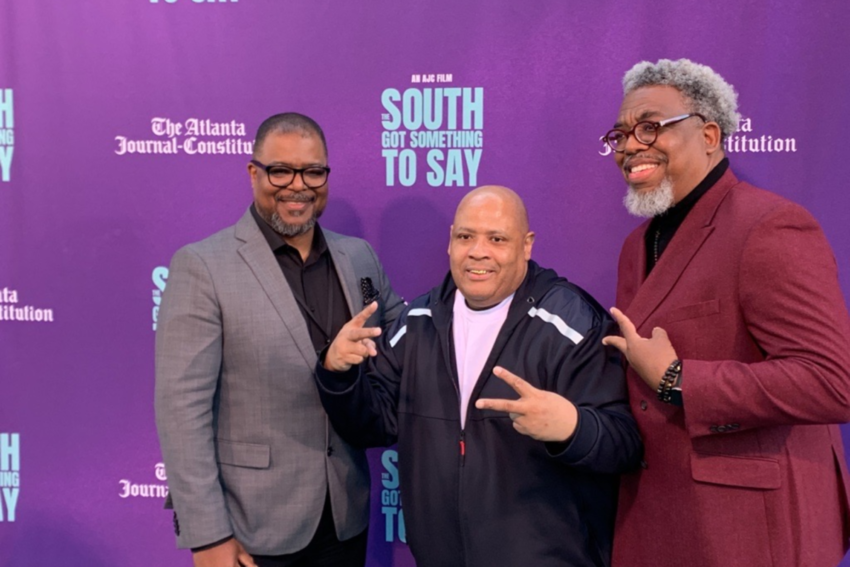
Atlanta Journal-Constitution Editor-in-Chief Leroy Chapman Jr., left, with MC Shy D, center, and AJC reporter Ernie Suggs at the premiere “The South Got Something to Say” on Nov. 2 in Atlanta. (Credit: GPB News)
Horne pointed to a Juneteenth concert the previous day by Kendrick Lamar in Inglewood, Calif.
“The Pop Out concert, especially the ending, was a moment for Kendrick and the entire West Coast to remind us that they are bigger than their tragedies,” David Dennis Jr. wrote for Andscape. “They’re resilient in their peace. Unyielding in their happiness. They’re unwavering in their love of the culture and unabashed in their willingness to dance when joy is at their feet. These are the things they popped out and showed us.”
The next stops on the film tour are at Los Angeles’ TCL Chinese Theater on Wednesday, the National Association of Black Journalists convention in Chicago, Aug. 1-4, and the Martha’s Vineyard African American Film Festival in Oak Bluffs on Aug. 6.
- Atlanta Journal-Constitution: WATCH NOW: The AJC’s hip-hop documentary ‘The South Got Something To Say’
- Louise Story and Ebony Reed, Capital B: Killer Mike’s Bankruptcy Journey Highlights Black Wealth Gaps (book excerpt)
To commemorate Juneteenth, CBS-TV’s “60 Minutes” reposted a video of its segment, “Descendants of Africans on slave ship on reconciliation with family of Alabama enslaver.” (Credit: YouTube)
H.L. Gates Jr.: Why Popular Juneteenth Story Strains Credulity
The same day Journal-isms published “No Stopping the Myth of Juneteenth’s Origin,” on June 18 — suggesting that such descriptions as “commemorating the end of slavery” would be more accurate — Charles M. Blow raised the issue in his New York Times column, writing:
“To start, there is some debate over whether most of the estimated 250,000 enslaved people in Texas at the time didn’t know about the Emancipation Proclamation. As the Harvard professor Henry Louis Gates Jr. told me recently, ‘I have never met a scholar who believes that’s true. ‘ ”
Journal-isms asked Gates (pictured, below) whether he was quoted accurately. This is his response.
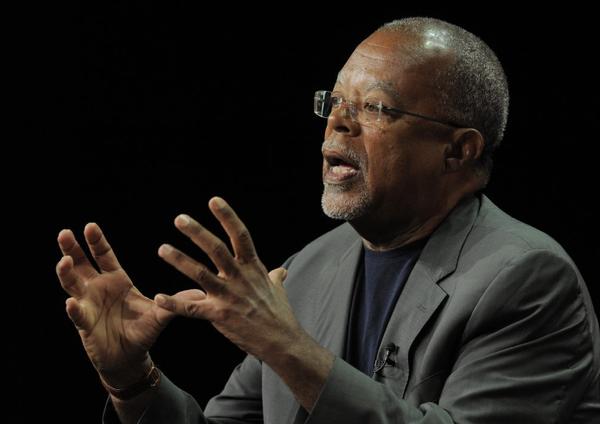 Yes, as always, Charles’s quotes are accurate. Let me say that it’s not like I have polled the entirety of the American Historical Association about the matter, but among the handful of historians with whom I have discussed this, none has said that they believe the standard account that somehow the enslaved sisters and brothers over in Texas were completely unaware of the Emancipation Proclamation.
Yes, as always, Charles’s quotes are accurate. Let me say that it’s not like I have polled the entirety of the American Historical Association about the matter, but among the handful of historians with whom I have discussed this, none has said that they believe the standard account that somehow the enslaved sisters and brothers over in Texas were completely unaware of the Emancipation Proclamation.
No one can say how many knew about it; no one polled the enslaved population at the time, of course.
But to claim that none of them had heard about it strains credulity, as does the assumption that a significant number of them had not already at least heard about it.
Why? For a couple of reasons. First, during the Civil War, many Confederates living in other parts of the South fled to Texas, because there was very little combat there, and brought with them tens of thousands of enslaved people from other parts of the South who in all probability had heard of the Emancipation Proclamation, of course. And they would have naturally mentioned it to other enslaved people.
Even under slavery, Black enslaved people mysteriously managed to communicate with each other far and wide, as even future President John Adams noted in a letter he wrote way back in 1775; Booker T. Washington called this “the ‘grape-vine’ telegraph.”
Second, surely house servants would have heard their masters going on and on about Abraham Lincoln, the North, the Civil War, and the threat that the Emancipation Proclamation posed to slaveholders if Union forces liberated an area, which entitled those enslaved people who could get behind those Union lines to their freedom — a key provision of the Emancipation Proclamation. And they would have shared the news with other enslaved people working in the fields.
For these two reasons alone, it is difficult to imagine how at least a large percentage of the 250,000 enslaved people living in Texas by 1865 would not have already heard about the Emancipation Proclamation before the end of the War.
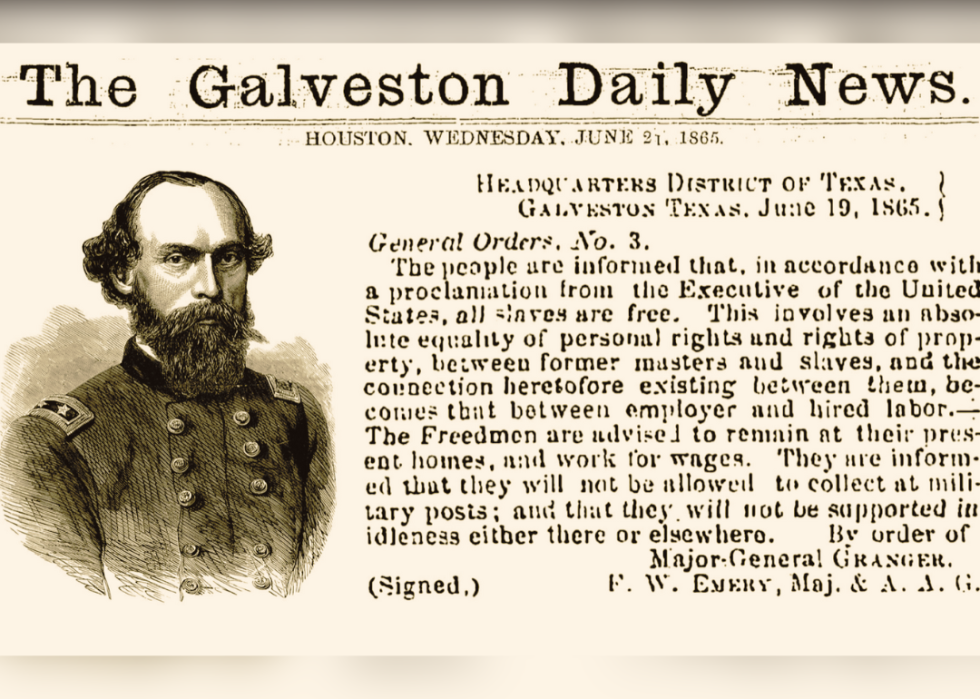 The key point about General Gordon Grainger’s General Orders, Number 3 – posted (but not read aloud, as the myth would have it) on June 19th, 1865, two months after Robert E. Lee’s surrender at Appomattox and two and a half years following the Emancipation Proclamation is that even after the Civil War ended, many former slaveholders refused to view the freed people as anything other than their property, no matter what the military or the government said.
The key point about General Gordon Grainger’s General Orders, Number 3 – posted (but not read aloud, as the myth would have it) on June 19th, 1865, two months after Robert E. Lee’s surrender at Appomattox and two and a half years following the Emancipation Proclamation is that even after the Civil War ended, many former slaveholders refused to view the freed people as anything other than their property, no matter what the military or the government said.
The reality of the matter is that even Granger’s order did not immediately lead to the freedom of all of the formerly enslaved people in Texas. Enslavers waited as long as possible to announce Granger’s order or honor the provisions of the order, determined to get the harvest in using slave labor. And then, too, the Freedmen’s Bureau didn’t arrive in Texas until that September, so about two and a half months later. And the freed people who took it upon themselves to leave their plantations often faced physical violence, ranging from beatings to murder.
What’s special about Juneteenth is that it is a holiday that was spontaneously created by Black people themselves. When June 19th rolled around in 1866, Black people in certain parts of Texas gathered to mark the anniversary of General Granger’s General Order, according to historians reading the Emancipation Proclamation out loud, reading passages from the Bible, and generally celebrating.
So I’m delighted that President Biden, at Miss Opal Lee’s prompting, made June 19th a national holiday!
Henry Louis Gates Jr. is the Alphonse Fletcher University Professor and director of the Hutchins Center for African & African American Research at Harvard University. He is described as “Emmy and Peabody Award-winning filmmaker, literary scholar, journalist, cultural critic, and institution builder.”
- Alicia Benjamin, the Grio: Two national parks to honor Black soldiers for Juneteenth
- Hayes Brown, MSNBC: The vibes are very off this Juneteenth
- Editorial, Los Angeles Times: Juneteenth isn’t a holiday just for Black people. Everyone should celebrate freedom
- Ryan Doan-Nguyen and Aaron Morrison, Associated Press: Jazz, justice and Juneteenth: Wynton Marsalis and Bryan Stevenson join forces to honor Black protest
- Emil Guillermo, Asian American Legal Defense and Education Fund: How to think about Juneteenth 2024
- Principal Chief Chuck Hoskin Jr., indianz.com: Cherokee Nation celebrates Juneteenth (June 24)
- Darren Sands, Associated Press: On Juneteenth, a journalist honors ancestor at ceremony for Black soldiers who served in Civil War
- Aallyah Wright, Capital B: Juneteenth Has Gone Mainstream. Should Everyone Be Celebrating?
“Looking back at the life and career of Willie Mays, his signature moment can be instantly recalled with two words: ‘The Catch.’ Jeff Passan shares more on the amazing feat that the ‘Say Hey Kid’ pulled off in the 1954 World Series.” (Credit:ESPN/YouTube)
Willie Mays Case Awakened Press to Bias in Housing
Baseball legend Willie Mays, who died Tuesday at 93, “never wanted to be an activist about anything off the baseball diamond. But the racism he encountered after moving to San Francisco stirred others to leap to his cause and ultimately helped motivate the city and state governments to outlaw housing discrimination,” columnist George Skelton wrote Saturday for the Los Angeles Times.
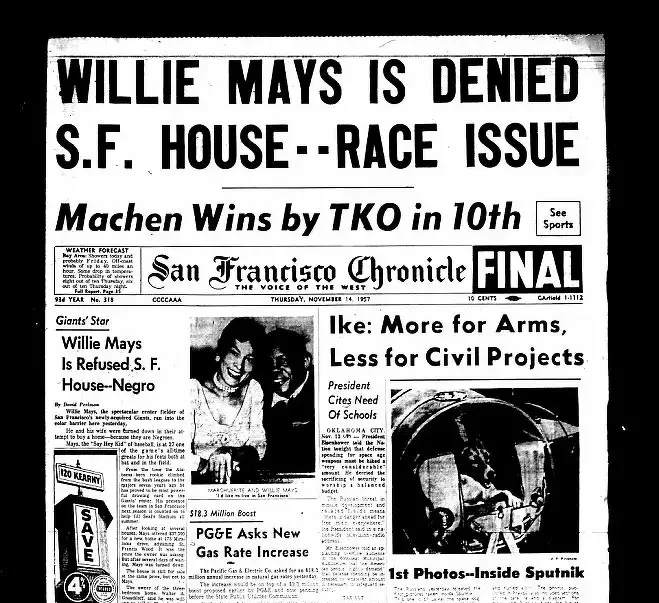 “His role began when Mays arrived in San Francisco from New York with the Giants baseball team in late 1957. Local folks in supposedly enlightened San Francisco welcomed the star outfielder by trying to bar him from a white neighborhood. . . .
“His role began when Mays arrived in San Francisco from New York with the Giants baseball team in late 1957. Local folks in supposedly enlightened San Francisco welcomed the star outfielder by trying to bar him from a white neighborhood. . . .
“Yes, that was San Francisco — in fact, virtually all of California — until laws were passed in the 1960s to stop such discrimination. The change was aided significantly by Mays’ indirect help, according to another legendary Willie from San Francisco — former mayor and longtime state Assembly Speaker Willie Brown.
“I called Brown, 90, after Mays died this week at age 93. Brown, a rare Black lawyer in late 1950s San Francisco, struck up an early friendship with Mays.
“ ‘He was a joy, frankly. A fun guy,’ Brown says.
“Brown credits the racial bias against Mays with galvanizing the city into adopting an ordinance forbidding housing discrimination.
“ ‘It started with Willie Mays,’ Brown told me. ‘As a result of his being rejected, newspapers suddenly became aware of the racism in San Francisco.
“ ‘San Francisco wasn’t racist like other parts of the country. People smiled.’
“Brown continued: ‘The fair housing law of San Francisco was passed because Mays got denied the right of housing. That escalated the need to change. He was the most dramatic example of how discrimination was practiced on people of color. . . .
“The San Francisco Chronicle got wind of the rejection and ran this banner at the top of Page 1: ‘WILLIE MAYS IS DENIED S.F. HOUSE–RACE ISSUE.’ . . .
“ ‘I didn’t figure I would have this much trouble trying to buy a place,’ Mays told a TV reporter. ‘When I go looking for a house, I don’t worry about who’s living beside me.’
“Unlike nervous white people of that era.
“San Francisco Mayor George Christopher — a moderate Republican, back when such a breed existed — offered to let Mays and his wife live temporarily at his home.
“Ultimately, the homeowner backed down, despite being berated by neighbors. Mays moved in. And almost immediately someone threw a brick through a window.
“Mays kept his mind on baseball and eventually became the pride of San Francisco. . . .”
- Kevin B. Blackistone, Washington Post: The enduring power of Willie Mays and the Catch
- Stacy M. Brown, National Newspaper Publishers Association: Breaking News: Baseball Legend Willie Mays Dies at 93
- Scott Chiusano, MLB.com: Willie Mays always knew he’d make The Catch
- Ronald Claiborne, Substack: Willie Mays: A Remembrance
- Wayne Dawkins, NABJ Black News & Views: A tribute to Willie Mays, baseball’s ‘Say Hey Kid’
- Josh Dubow, Associated Press: Willie Mays Appreciation: The ‘Say Hey Kid’ inspired generations with talent and exuberance
- Sarah Feldberg, San Francisco Chronicle: S.F. Chronicle to honor the great Willie Mays in new hardcover collector’s book
- Renée Graham, Boston Globe: Saying goodbye — and thank you — to the ‘Say Hey Kid’
- Roy S. Johnson, al.com: Never say ‘Greatest living’ again, Mays has no successor
- James S. Hirsch, Boston Globe: Willie Mays paid a high price to be Willie Mays
- Terence Moore, Forbes: Willie Mays Delivered A Barry Bonds Phone Call For The Ages
- Scott Ostler, San Francisco Chronicle: Giants’ Rickwood Field game doubled as a lesson on racism in old-time baseball
- William C. Rhoden, Andscape: Willie Mays and the birth of cool in sports
- Shakeia Taylor, Chicago Tribune: A powerful night at Rickwood Field, where Willie Mays wasn’t present but was everywhere
- Clinton Yates, Andscape: Rickwood Field, Willie Mays and the balance of celebration and commemoration

At ESPN, John Ourand wrote for Puck, “Stephen A., for better or worse, is their Rachel Maddow: homegrown, polarizing but beloved, beyond parody. And probably one of the only remaining sports media talents worthy of old-school dough.” (Credit: ESPN)
Stephen A. Smith Reportedly Seeking $25M a Year
“A generation ago, when he was just a rake in his progress on the set of The Sports Reporters, no one would have guessed that the New Yorker turned Philly sportswriter Stephen A. Smith would one day become the biggest name on ESPN — the heir to Schaap and Berman, Patrick and Olbermann, Mike and Tony, etcetera,” John Ourand wrote Thursday for Puck.
“ESPN has been working hard to re-sign Smith, whose contract ends in a year; last week ESPN made its initial offer of $18 million per year for five years. I’m told ESPN execs pitched Smith’s WME agents that he would be their highest-paid star, earning more than Monday Night Football’s Troy Aikman or Joe Buck.
“Will that be enough? Smith has reportedly been seeking some $25 million per year. While $18 million might seem like a ton of dough, I’m told Stephen A. wants McAfee bucks. Indeed, WME’s response to ESPN was to point to Pat McAfee’s deal, which nets close to $30 million per year between his studio show and College GameDay appearances. WME also had the chutzpah to use ESPN’s $700 million deal with Peyton Manning’s Omaha Productions as a comp.
“ESPN, of course, is crying foul on those comps, pointing out that neither is a talent contract and that they are both production deals. ESPN buys McAfee’s show, which includes all the costs he pays for the production and staff. . . . “
Yahoo Writer Casts Doubt on Jordan’s Record
“It may be the most consequential Defensive Player of the Year award in NBA history,” Tom Haberstroh reported Thursday for Yahoo Sports.
“In 1987-88, Michael Jordan became the first player ever to win the scoring title and the DPOY in the same season. To this day, the feat hasn’t been duplicated.
“Considerable evidence — both statistical and corroborating video — suggests that Jordan’s Defensive Player of the Year award may not be as valid as we thought. . . .”
Vega Reports on Alleged Saudi Complicity in 9/11
“For more than two decades, the U.S. position has been that al Qaeda acted alone on September 11th, but a newly public video has raised questions about whether the Saudi government provided crucial assistance to the hijackers during the 9/11 terror attacks,” Cecilia Vega reported Thursday for the “CBS Evening News,” in what was touted as an exclusive. A more complete report is scheduled for “60 Minutes” Sunday.
“Omar al-Bayoumi, whom the FBI says was an operative of the Saudi intelligence service with close ties to two of the 9/11 hijackers, can be heard on the video, which was unsealed in federal court this week and obtained by 60 Minutes. The 1999 video was taken within 90 days of the time when senior al Qaeda planners were deciding on 9/11 targets, Richard Lambert, a retired FBI agent who led the initial 9/11 investigation in San Diego, said. continued Vega.
” ‘It is another very large brick in a massive wall of evidence that at this point indicates the Saudi government was complicit in the 9/11 attacks,’ Lambert said. . . .”
When Vega left ABC to join “60 MInutes” last year, she became the first Latina correspondent on the program in its 55-year history.
“Highland Park is a community that, at times, has been forgotten. But now, it’s time to hear the stories of victory, resilience, hope, and the future,” Detroit’s WDIV-TV advertised. “Starting Monday, June 3, Local 4’s Karen Drew is spending 24 hours in the Detroit enclave to focus on the many stories of this passionate city.” (Credit: WDIV-TV/YouTube)
Station Live for 24 Hours From Detroit Neighborhood
“At 6 o’clock in the morning on Monday, June 3, Karen Drew, an anchor/reporter for WDIV, Graham Media’s NBC affiliate in Detroit, was doing a live shot in the kitchen of a Highland Park resident as she was making breakfast for her kids,” Paul Greeley reported Friday for the subscription-only NewsBlues site.
“ ‘While you cook, we can chit-chat,’ Drew says.
“It was the first stop of Drew’s 24-hour live coverage from Highland Park, a city within the city of Detroit. Drew’s coverage was unscripted, unedited, unfiltered, a first of its kind event for local TV.
“Drew did a live report in every newscast from 6 in the morning until 11 at night, plus two more the following day for broadcast.
“In addition to doing a live shot on broadcast, she was live for the streaming audience.
“WDIV television viewers could watch her live during any of the station’s newscasts that day and streamers could follow on ClickOnDetroit.com and WDIV’s Local 4+ streaming app.
“ ‘My live shots on streaming were anywhere from five to 25 minutes long,’ Drew says. ‘My first live shot was 21 minutes, and my producer was like, oh my gosh, this is awesome.’ . . .
“The event was a collaboration between WDIV and the Michigan Chronicle, a weekly African American newspaper based in Detroit.
“Why spend 24 hours in Highland Park, a forgotten neighborhood whose streets are dark because the electric company removed 1,400 streetlights because the city was unable to pay its light bill?
“ ‘I don’t think I would have done this in any other place,’ Drew says. ‘It all started with Mama Shu.’
“Shamayim ‘Mama Shu’ Harris, founded Avalon Village, a sustainable eco-village in Highland Park after her two-year old son, Jakobi, was killed in a hit and run accident in 2007. In 2021, her 23-year-old son, Chinyelu, was shot and killed while doing a neighborhood watch.
“Drew says she’s been covering the accomplishments of Mama Shu and what she’s done in Highland Park for 10 years. . . .”
- Karen Drew, WDIV-TV: Why we’re spending 24 hours in Highland Park
Rose Tibayan, TV Journalist, Mentor Dies at 54
 Rose Tibayan (pictured), a television journalist who went on to become director of public affairs at Chicago’s Department of Budget, Management and Finance under former Mayor Lori Lightfoot, died Thursday at her home in Galena, Ill., after a 14-month battle with cancer, the Chicago Federation of Labor reported. She was 54.
Rose Tibayan (pictured), a television journalist who went on to become director of public affairs at Chicago’s Department of Budget, Management and Finance under former Mayor Lori Lightfoot, died Thursday at her home in Galena, Ill., after a 14-month battle with cancer, the Chicago Federation of Labor reported. She was 54.
Tibayan began her television news career in New York as a production assistant for NBC Weekend Nightly News. She went on to produce, write, report and/or anchor for television news stations in Guam; Fort Myers, Fla.; New York and Philadelphia.
A short bio accompanying her 2007 book “RÉSUMÉTAPEBOOK: The Job-Hunting Handbook for Television Journalists,” says, “Rose has covered a range of local, national and international stories. For five years she was a mentor with the UNITY: Journalists of Color Mentor Program and has served on the local boards of the Asian American Journalists Association in Florida and New York. She was born in Manila, Philippines and grew up in Newark, Delaware where she earned a Bachelor of Arts degree from the University of Delaware.”
In addition, “In 2014, Rose founded the Sampaguita Group, a non-profit organization which tackles the issue of downward mobility of second-generation Filipino Americans pursuing higher education. The organization awards scholarships to Filipino American female college students. To further promote women, Rose launched Ligaya, an online magazine that chronicles the life and times of Filipino American women.” according to another bio.
“Before falling ill in April 2023, she was looking forward to working with incoming Mayor Brandon Johnson,” the Chicago Federation of Labor said.

Dozens of Ethiopian journalists have fled since 2020 due to harassment and persecution. They include (clockwise from top left): Tesfa-Alem Tekle, Woldegiorgis Ghebrehiwet Teklay, Belete Kassa, Yayesew Shimelis, and Guyo Wariyo. (Photos: Courtesy Tesfa-Alem Tekle; YouTube screenshots from Yabele Media, Ethio News, Ethio Forum, Oromia Media Network)
Journalists Pushed Into Exile in Record Numbers
“Threats, repression, conflict, and unrest: across the world, these and other factors are pushing journalists into exile in record numbers,” Lucy Westcott, emergencies director, reported for the Committee to Protect Journalists.
“In a striking development, exiled or soon-to-be exiled journalists now make up more than half of the people CPJ assists. Between January and June 2024, CPJ provided financial support to 158 journalists; 101, or about 64% of these people had fled their home countries or were in the process of fleeing from countries such as Myanmar, Nicaragua, and Sudan. Overall, CPJ’s exile support to members of the press grew by 227% between 2020 and 2023.
“These figures demonstrate the dire needs of journalists in exile, and the bitter reality that exile is not the end of a journalist’s problems but in many cases just the beginning.
“Unless journalists have dual citizenship, preexisting visas, or the ability to acquire an emergency visa, they may have to remain in a transit country while seeking permanent resettlement to a third country, a process that can take months or years. Many transit countries have poor press freedom records, leaving exiled journalists vulnerable to further harm. But even those who make it to ‘safe’ countries aren’t really safe; many face transnational repression as authorities in their countries of origin continue to issue threats and target family members back home.
“Some countries of refuge are undergoing democratic backsliding, with implications for the exile and local press. . . .”
- Committee to Protect Journalists: Fleeing prolonged media crackdown, Ethiopian journalists struggle in exile
- John Otis, Committee to Protect Journalists: Drug-related violence fuels an exodus of Ecuador’s press (June 18)
- Wallace House Center for Journalists, University of Michigan: A Lifeline for Journalists at Risk (May 3)

“One route starts in West Africa, with migrants paying up to $10,000 for multi-stop commercial flights to Nicaragua, before continuing by land to the U.S.” (Credit: Foreign Policy)
Migrants Now Smuggled Via Pricey Charter Flights
Charter flights “represent a new phase of illegal immigration to the U.S., five U.S. officials said in interviews with Reuters,” Mica Rosenberg, Rupam Jain and Jackie Botts reported Friday for Reuters, in partnership with Churchill Ndonwie and Jose Maria Del Pino of Columbia Journalism Investigations.
“Increasingly, they said, migrants from outside Latin America are paying smuggling networks hefty fees for travel packages that can include airline tickets – on charter and commercial airlines – to fly to Central America and then bus rides and hotel stays en route to the U.S.-Mexico border. . . . as some routes for illegal migration get squeezed, others open up. . . .
“Reuters and Columbia Journalism Investigations, the university’s postgraduate reporting program, traced two new intercontinental migrant smuggling routes. The reporting for this story draws from previously unreported aviation data, border figures obtained through Freedom of Information Act requests, and close to 100 interviews with government officials, police, airline employees, smugglers, travel agents and migrants in nine countries.
“One route starts in West Africa, with migrants paying up to $10,000 for multi-stop commercial flights to Nicaragua, before continuing by land to the U.S.
“The second, serving migrants from India, offers charter flights to Central America and overland transfers to the U.S. border for between 6 million ($72,000) and 8 million rupees ($96,000) per person – in many instances with full payment due after arrival in the U.S, according to Indian court documents and K.T. Kamariya, a deputy superintendent of police in the western Indian state of Gujarat investigating illegal migration.”
One example: “Late on the evening of Aug 28, Ismaila Diop, 30, a small-business owner from Senegal, landed at Managua aboard Avianca flight TA315. On arrival, Diop said he paid $160 for a tourist visa and got a taxi from the airport to the Honduran border, five hours away. His Nicaraguan driver confirmed the trip and the $50 fare.
“Diop flew from Dakar to Rabat to Madrid, where he boarded an Avianca flight to Managua with layovers in Bogota and San Salvador, ticket stubs and photos show.
“Engaging in gay sex is criminalized in Senegal. Diop, who identifies as bisexual, said he fled after a severe beating left him unable to work for close to a month. His account was confirmed by medical records, photos and asylum documents reviewed by Reuters and CJI. . . . “
Separately, Renata Brito, 31, of The Associated Press won a Livingston Award from the Wallace House Center for Journalists at the University of Michigan for “Adrift/36 Days,” “a visually-driven investigation that seamlessly weaves together graphic illustrations, evocative imagery and powerful storytelling. Through meticulous detail, Brito reconstructs the journey of a boat discovered on Tobago’s coast, identifies its deceased passengers and humanizes the plight of migrants.”
- Elvia Malagón, Chicago Sun-Times/WBEZ: Why we traveled to Toronto to learn about immigration: Canada is known for its friendlier approach to immigration, but it also faces hurdles as record numbers of people are displaced globally.
View this post on Instagram
Why ‘Minority’ Doesn’t Work for David Oyelowo
In the “Fresh Air” interview quoted in the first item about “The South Got Something to Say,” Black British actor David Oyelowo also discussed what he called the “minority mentality,” touching on ongoing debates about the use of the term. From the transcript:
TONYA MOSLEY: Something you mentioned, I’ve heard you talk about, and growing up In Nigeria was the sense of self? You didn’t suffer from minority mentality — is that the term that you use?
OYELOWO: Right.
MOSLEY: Right. So by the time you got to the U.K., went back to the U.K…
OYELOWO: Yeah.
MOSLEY: …You had a deep sense of self, because, you know, you’re just around all people who look like you in Nigeria. It’s very similar to how I grew up in Detroit – like, everything was Black. My church was Black. My school was Black. My neighborhood was Black. So my sense of self was pretty strong by the time I went on to the greater world. Have you thought about that? How do you grapple with that?
OYELOWO: Yeah, there are so many things that are constructs that torpedo our sense of self.
“If you’re constantly being told you’re a minority, if you have the notion that you are a diversity hire, if you are constantly being reminded of your race in a negative way – these are things that subconsciously work their way into how you think of yourself.
“If you are watching films and television shows where you are constantly the best friend, the Black best friend or the magical Negro as we know that trope, or you’re just constantly tangential, superfluous or peripheral to the narrative, you are gathering data as to what your skin, plus the world, or that culture or community that you are within, how it feels about you, where it places you on the hierarchy of things.
“Now, if you grow up in a community, like I did in Lagos, Nigeria, where every image, every bit of stimulus I am receiving is telling me I am central to the life of that community, that is also something that is – you’re internalizing and [that] affects your disposition as you go out into the world.
“So the minority mentality is something I was able to discern when I moved back to the U.K. at the age 13. Being in Nigeria from 6 to 13 and suddenly this notion of race. Race as a construct — it’s a construct to help us rationalize, to be perfectly frank, some of the terrible things we have done to each other through history as opposed to just feeling like a human being.
“When I get out of bed every morning, I do – my first thought is not I’m a Black man.
MOSLEY: Sure, sure.
OYELOWO: “You know what I mean? I’m David. I’m a human being. I love my wife. I love my kids. Are they OK? Let me go feed the dogs. Going to hit the – you know, these are the thoughts that – but then, very quickly, as I exit my door, there is stimulus hitting me that is deeming me anomalous, deeming me different, deeming me problematic at times or deeming me angry at the world or whatever it is. And sometimes that becomes a self-fulfilling prophecy. Sometimes it’s something you’re fighting against. But both of those things are negative.
“And I call it actually – another phrase I use is the Sidney Poitier syndrome. When you look at what he achieved in this country at that time, something that if you were a Black actor today, you know, winning the awards he did, having the acclaim he did, working with the directors he did, being number one on the call sheet at the time he was. Even today, that’s a challenge.
How did he achieve that? It’s because he grew up in the Caribbean. Where again, he didn’t have – yeah. He didn’t have a minority mentality. So he was walking into rooms, circumstances and situations with a disposition that didn’t have him in a boxer stance the whole time. He had an ease to the way he was confronting the world, because he didn’t feel like he was constantly at war with it.
MOSLEY: David Oyelowo, thank you so much for this conversation.
- Journal-isms: ‘People of Color’ Phrase Makes the Front Page (June 2) (scroll down)
- Journal-isms: NAHJ Urges End to ‘Minorities’ Label (Aug. 15, 2020)
Short Takes
- “Robert Winnett, the British journalist recently tapped to become editor of The Washington Post later this year, will not take the job and will remain at the Daily Telegraph in London, according to a company email sent to Post employees Friday morning,” Elahe Izadi and Isaac Stanley-Becker reported Friday for the Post. Publisher Will Lewis said “that an outside firm would be used to conduct a ‘timely but thorough search’ for a replacement. . . . The unraveling of that hiring also delays Lewis’s plans to reorganize The Post. He had intended to launch a new department this year that would function alongside the company’s opinion and traditional newsgathering sections, aiming to reach new audiences with social-media-driven and service journalism. The third newsroom will now launch sometime during the first three months of 2025, Lewis wrote in Friday’s note to staff. . . .”
 “In a significant move towards enhancing media practices, Arizona State University’s Walter Cronkite School of Journalism and Mass Communication has named Chelsea Reynolds (pictured) as the inaugural director of the newly established Center for Culture and Inclusion in Media,” Editor & Publisher reported Friday. “This center aims to spearhead research and initiatives that bridge the gap between academia and industry while promoting inclusive media practices and focusing on a range of critical issues such as mis/disinformation, media representation and workplace dynamics.”
“In a significant move towards enhancing media practices, Arizona State University’s Walter Cronkite School of Journalism and Mass Communication has named Chelsea Reynolds (pictured) as the inaugural director of the newly established Center for Culture and Inclusion in Media,” Editor & Publisher reported Friday. “This center aims to spearhead research and initiatives that bridge the gap between academia and industry while promoting inclusive media practices and focusing on a range of critical issues such as mis/disinformation, media representation and workplace dynamics.”
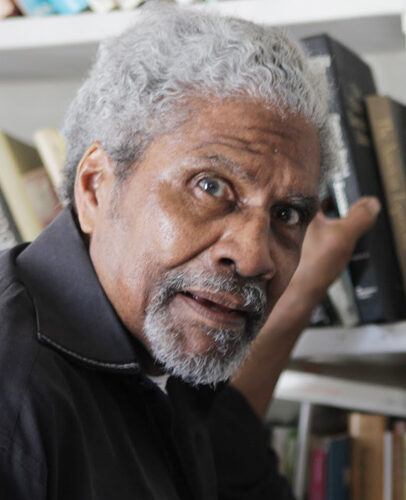 “Nathan Hare (pictured), a sociologist who helped lead a five-month strike by faculty members and students at what is now San Francisco State University, resulting in an agreement in 1969 to create the country’s first program in Black studies, with him as its director, died at a hospital in San Francisco on June 10. He was 91,” Clay Risen reported Friday, updated Saturday, for The New York Times. Also in 1969, “Dr. Hare joined the poet Robert Chrisman and Allan Ross, a printer, to found The Black Scholar in Oakland (today it is published by Boston University). In interviews, he described it as a forum for connecting artists, activists and intellectuals with the emerging ‘ebony tower’ of Black studies, feeding it ideas and arguments. The journal quickly became one of the leading Black intellectual publications, with essays by thinkers like Amiri Baraka and Angela Davis. . . .”
“Nathan Hare (pictured), a sociologist who helped lead a five-month strike by faculty members and students at what is now San Francisco State University, resulting in an agreement in 1969 to create the country’s first program in Black studies, with him as its director, died at a hospital in San Francisco on June 10. He was 91,” Clay Risen reported Friday, updated Saturday, for The New York Times. Also in 1969, “Dr. Hare joined the poet Robert Chrisman and Allan Ross, a printer, to found The Black Scholar in Oakland (today it is published by Boston University). In interviews, he described it as a forum for connecting artists, activists and intellectuals with the emerging ‘ebony tower’ of Black studies, feeding it ideas and arguments. The journal quickly became one of the leading Black intellectual publications, with essays by thinkers like Amiri Baraka and Angela Davis. . . .”
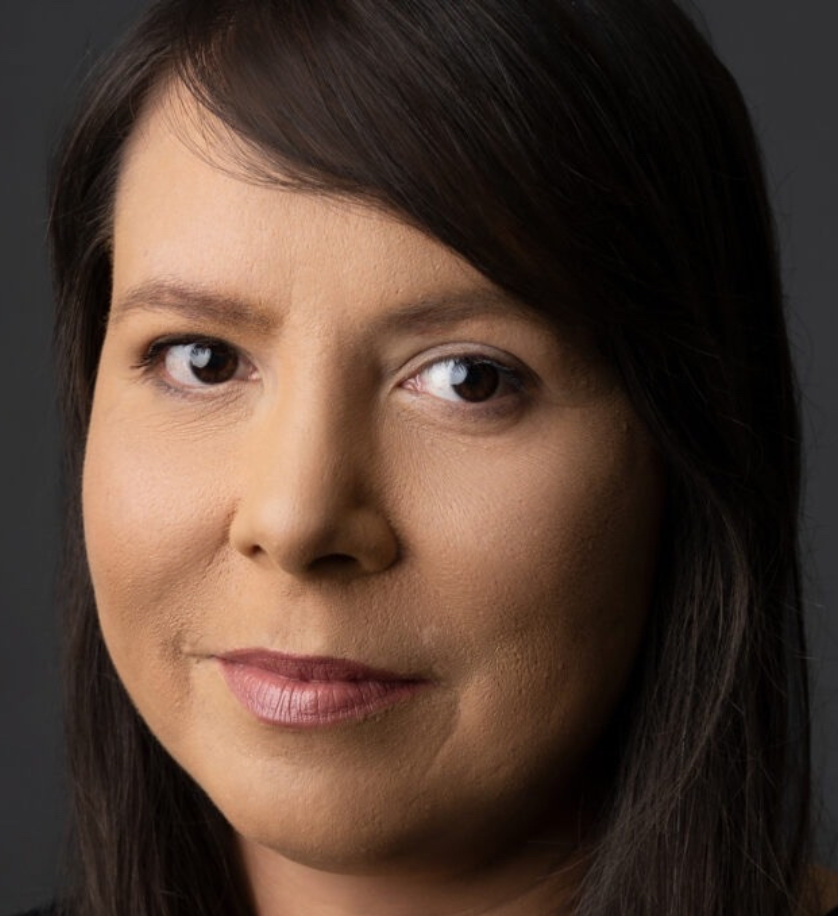 “The Indigenous Journalists Association (IJA) has selected ProPublica reporter Mary Hudetz (pictured) (Apsaalooke/Crow) as the recipient of the 2024 Richard LaCourse Award for Investigative Journalism, which recognizes groundbreaking work by journalists that creatively use digital tools in the role of community watchdog,” the association announced Tuesday. “The committee selected Hudetz for her work with ProPublica’s The Repatriation Project – The Delayed Return of Native Remains. The project highlights how museums and universities have actively fought against repatriating Native American remains and sacred objects plundered over centuries. . . .” Hudetz is a former president of the organization, formerly the Native American Journalists Assoiation.
“The Indigenous Journalists Association (IJA) has selected ProPublica reporter Mary Hudetz (pictured) (Apsaalooke/Crow) as the recipient of the 2024 Richard LaCourse Award for Investigative Journalism, which recognizes groundbreaking work by journalists that creatively use digital tools in the role of community watchdog,” the association announced Tuesday. “The committee selected Hudetz for her work with ProPublica’s The Repatriation Project – The Delayed Return of Native Remains. The project highlights how museums and universities have actively fought against repatriating Native American remains and sacred objects plundered over centuries. . . .” Hudetz is a former president of the organization, formerly the Native American Journalists Assoiation.
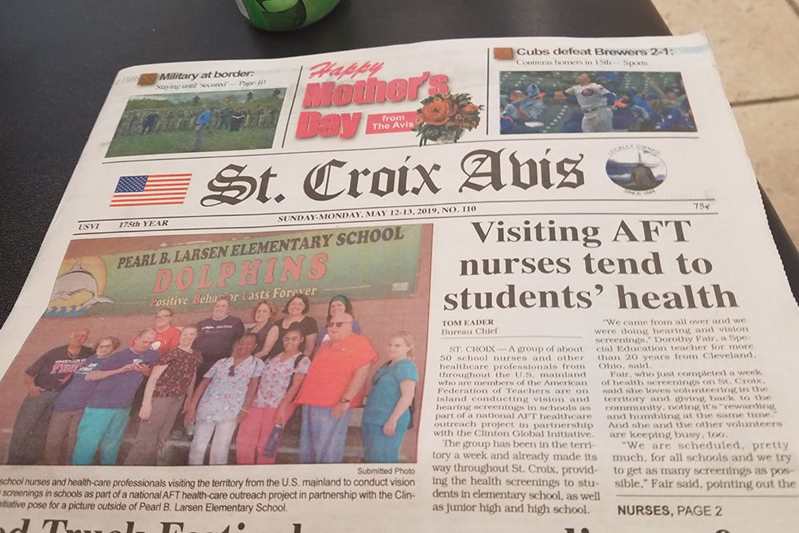 “After a 180-year reign, the longest-running print newspaper in the U.S. Virgin Islands announced in January that it would cease publication. The paper’s owner and publisher, Rena Brodhurst, shared the news with readers in a letter published in their Sunday-Monday print edition,” Amaziah George reported Friday for State of the Territory News, published in the Virgin Islands. George also wrote, “In an age where social media is free, and email marketing is cheap and simple, the Avis managed to blame everyone but itself for its demise. Back in 2019, the Avis began preparing to enter the digital age and was reportedly working on a new website. The website never materialized. Now history will remember why the Avis shut its doors: it was because email and social media were too hard.”
“After a 180-year reign, the longest-running print newspaper in the U.S. Virgin Islands announced in January that it would cease publication. The paper’s owner and publisher, Rena Brodhurst, shared the news with readers in a letter published in their Sunday-Monday print edition,” Amaziah George reported Friday for State of the Territory News, published in the Virgin Islands. George also wrote, “In an age where social media is free, and email marketing is cheap and simple, the Avis managed to blame everyone but itself for its demise. Back in 2019, the Avis began preparing to enter the digital age and was reportedly working on a new website. The website never materialized. Now history will remember why the Avis shut its doors: it was because email and social media were too hard.”
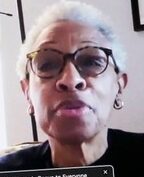 Veteran journalist Sheila Solomon, co-founder and vice chair of Journalism Funding Partners, is hosting Aging Rewired, a new podcast by Senior Planet from AARP, “exploring the intersections of aging and technology through insightful conversations.” The first episode begins June 26. (Photo by Sharon Farmer/sfphotoworks)
Veteran journalist Sheila Solomon, co-founder and vice chair of Journalism Funding Partners, is hosting Aging Rewired, a new podcast by Senior Planet from AARP, “exploring the intersections of aging and technology through insightful conversations.” The first episode begins June 26. (Photo by Sharon Farmer/sfphotoworks)
 Lee Hawkins (pictured), a veteran journalist formerly at The Wall Street Journal and now a podcaster and author, told Laura Yuen of the Star Tribune in Minneapolis Tuesday, “My father kept secrets from me about his time in Alabama, and his parents kept secrets from him. It was a dark cloud that always hung over me. I was a Black kid up north who knew I had cousins and connections and cultural traditions that traced back to the South, but I knew nothing about the South.” Yuen wrote, “What he eventually learned is the subject of his new 10-episode podcast with St. Paul-based APM Studios, ‘What Happened in Alabama?’ and his book, ‘I Am Nobody’s Slave: How Uncovering My Family’s History Set Me Free,’ to be published early next year by HarperCollins. . . .”
Lee Hawkins (pictured), a veteran journalist formerly at The Wall Street Journal and now a podcaster and author, told Laura Yuen of the Star Tribune in Minneapolis Tuesday, “My father kept secrets from me about his time in Alabama, and his parents kept secrets from him. It was a dark cloud that always hung over me. I was a Black kid up north who knew I had cousins and connections and cultural traditions that traced back to the South, but I knew nothing about the South.” Yuen wrote, “What he eventually learned is the subject of his new 10-episode podcast with St. Paul-based APM Studios, ‘What Happened in Alabama?’ and his book, ‘I Am Nobody’s Slave: How Uncovering My Family’s History Set Me Free,’ to be published early next year by HarperCollins. . . .”
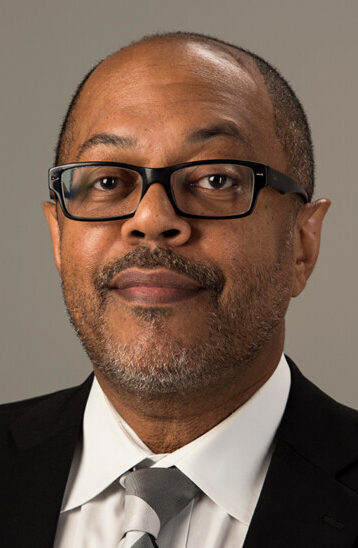 “The Livingston Awards honored Kevin Merida (pictured), former executive editor of the Los Angeles Times, with the Richard M. Clurman Award for mentoring, the Wallace House for Journalists at the University of Michigan announced Jan. 11. “The prize is given each year to an experienced journalist who has played a pivotal role in guiding and nurturing the careers of young reporters. In a video tribute, journalists from the Los Angeles Times, ESPN and The Washington Post talked about Merida’s encouragement of young reporters and his influence on their careers.”
“The Livingston Awards honored Kevin Merida (pictured), former executive editor of the Los Angeles Times, with the Richard M. Clurman Award for mentoring, the Wallace House for Journalists at the University of Michigan announced Jan. 11. “The prize is given each year to an experienced journalist who has played a pivotal role in guiding and nurturing the careers of young reporters. In a video tribute, journalists from the Los Angeles Times, ESPN and The Washington Post talked about Merida’s encouragement of young reporters and his influence on their careers.”
- “Sean Yoes, a staple of the journalism community in the D.C., Maryland and Virginia area and beyond, speaks on his humble beginnings in the Black Press. Jenise Griffin is publisher of the Daytona Times, where her career began decades ago after graduating from Florida A&M University. William Rhoden is just one of the many successful Black journalists to credit Black Press with the success of his media career,” Aria Brent wrote Saturday for the Afro-American in Baltimore.
- “Our America: In the Black, a series from ABC Owned Television Stations, returns Thursday, June 20 with the nine-part Conversations With Arlan Hamilton. An entrepreneur and author, Hamilton focuses on financial health and wellness. Each episode features a discussion with guests from business, entertainment and technology, who share stories and insights on financial health,” Michael Malone reported Thursday for Broadcasting & Cable.
- Reporters Without Borders (RSF) said Tuesday it “condemns the Guinean government’s illegal decision to strip six privately-owned independent broadcasters – four radio stations and two TV channels – of their operating licences, despite earlier pledges. The Economic Community of West African States (ECOWAS) must press the Guinean authorities to stop censoring the media, RSF says.” The press-freedom group added, “Defending the latest measures in a press release on 24 May, the government claimed that ‘certain media outlets are failing in their responsibilities by not complying with the laws on press freedom, the [media regulator] HAC and the Code of Good Conduct for Journalists.’ The censored outlets, which are owned by three of Guinea’s biggest commercial media groups, are all outspoken and critical in their reporting. . . . “
- “Nigerien authorities must decriminalize defamation and ensure that the country’s cybercrime law does not unduly restrict the work of the media,” the Committee to Protect Journalists said on Thursday. “On June 7, Niger’s head of state Abdourahamane Tchiani, who overthrew the democratically elected president in July 2023, reintroduced prison sentences of one to three years and a fine of up to 5 million CFA francs (US$8,177) for defamation and insult via electronic means of communication, according to news reports. . . .”
- “The decision by Burkina Faso’s media regulatory body to suspend broadcasts of the French news network TV5 is the latest attempt to crack down on independent media and access to information in the West African country,” Ilaria Allegrozzi wrote Thursday for Human Rights Watch. Allegrozzi also wrote, “On June 18, Idrissa Ouédraogo, head of the Superior Council for Communication (Conseil supérieur de la communication) announced the suspension of TV5 for six months for airing an interview the previous day with Newton Ahmed Barry, former head of the Burkinabé electoral commission and critic of the military junta, on the country’s security situation. . . .”
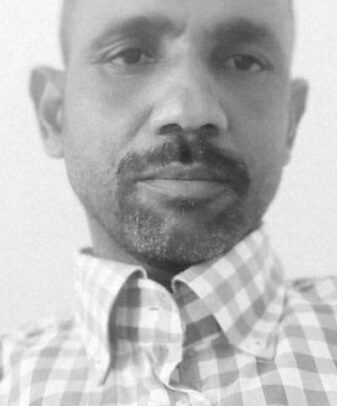 “Media representatives in Darfur have condemned the detention of Sudan TV journalist Ahmed Jamam (pictured), who was detained in El Fasher two weeks ago, according to his family,” Dabanga, “an independent Sudanese news and information broadcaster and publisher, reported Thursday from London. “Several organisations have condemned campaigns of detentions across Sudan by all parties to the conflict, and the UK Foreign Office has highlighted the risk of criminal kidnapping in an updated travel advisory. . . . Media activity has been severely curtailed across Sudan following the outbreak of the current hostilities in April 2023. The Sudan Media Forum, a coalition of independent media outlets and organisations, including Radio Dabanga, laments that ‘all press and media institutions operating inside the country ceased operations, journalists have been displaced and lost their jobs. This interruption of professional and field news coverage has created a ‘media blackout’ across the country.’ . . . ”
“Media representatives in Darfur have condemned the detention of Sudan TV journalist Ahmed Jamam (pictured), who was detained in El Fasher two weeks ago, according to his family,” Dabanga, “an independent Sudanese news and information broadcaster and publisher, reported Thursday from London. “Several organisations have condemned campaigns of detentions across Sudan by all parties to the conflict, and the UK Foreign Office has highlighted the risk of criminal kidnapping in an updated travel advisory. . . . Media activity has been severely curtailed across Sudan following the outbreak of the current hostilities in April 2023. The Sudan Media Forum, a coalition of independent media outlets and organisations, including Radio Dabanga, laments that ‘all press and media institutions operating inside the country ceased operations, journalists have been displaced and lost their jobs. This interruption of professional and field news coverage has created a ‘media blackout’ across the country.’ . . . ”
Reporter Alexia Fernández Campbell discusses “40 Acres and a Lie” Monday with Amna Nawaz on the “PBS News Hour.” (Credit: YouTube)
’40 Acres and a Lie,’ Matt Murray, Mentoring Black Male Journalism Students Are July 1 Roundtable Topics
That’s the short summary for the more than two-year investigation by the Center for Public Integrity and Reveal, from the Center for Investigative Reporting, that unearthed thousands of records once buried in the National Archives.
“In them, they found more than 1,200 formerly enslaved people who were given land by the federal government through the field orders – and then saw that land taken away.” The results are presented in a three-part podcast that began last Saturday.
Journalists behind the project will be guests at our next Journal-isms Roundtable by Zoom, to be simulcast on Facebook on Monday, July 1, at 7 p.m. Eastern. The Facebook page is “Richard Prince’s Journal-isms, < https://www.facebook.com/RPjournalisms/ >
Joining us will be reporters Alexia Fernández Campbell and April Simpson, and story editors Mc Nelly Torres (tentatively) and Matt DeRienzo, who was editor-in-chief of the Center for Public Integrity during the investigation.

Matt Murray addresses the Washington Post staff on June 3. (Credit: Robert Miller/Washington Post)
We will also toast Matt Murray, new interim executive editor of The Washington Post, who was editor in chief of The Wall Street Journal from 2018 to 2023. In his initial meeting with a contentious Post newsroom on June 3, Murray said that diversity would be a “constant commitment” at the Post, adding that he had “the most diverse masthead that The Journal had ever had” during his years as the top editor at the Journal, The New York Times reported.
In 2020, Murray named Brent Jones to the WSJ masthead, making Jones the first African American so designated (though mastheads used to be smaller).
I promised Murray that he would not have to stay long.
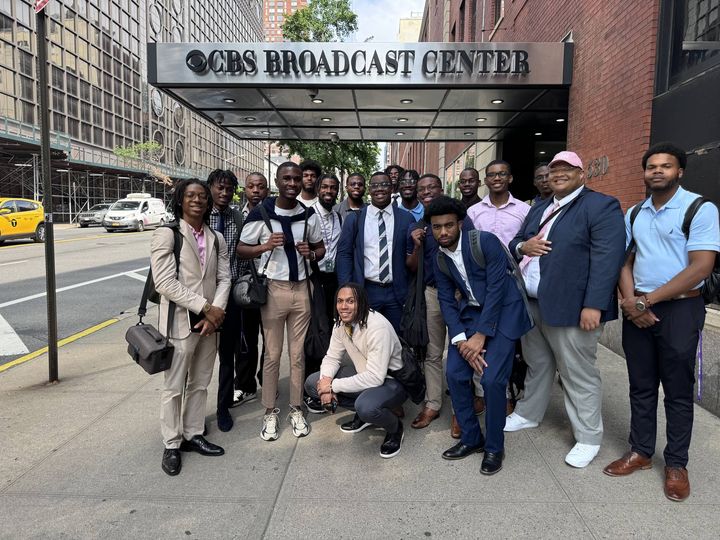
The Black Male Journalism Workshop seeks “all U.S. college students who appreciate our mission to support the representation of Black males in journalism, regardless of their identity or background,” said the announcement launching the project. (Credit: Jason Samuels)
As a bonus, Shirley Carswell, director of the Dow Jones News Fund and a longtime Roundtable member, will briefly update us on the just-concluded inaugural Black Male Journalism Workshop, a collaboration between the New York University Arthur L. Carter Journalism Institute and the Dow Jones News Fund.
The project was originally announced at last year’s National Association of Black Journalists convention in Birmingham, Ala. (scroll down)
Writing informally, executive director Jason Samuels of NYU offered “thanks to all of our hosts and guest speakers who made time to engage with our incredible group of college journalists:” Marc Lacey (managing editor- nyt), Henri Cauvin (deputy editor, national – nyt), Greg Winter (managing editor, international – nyt), Mike Abrams (deputy editor, standards – nyt), Brent jones (svp – dow jones), Darren Everson (chief digital editor – wsj),
 Michelle Higgins (newsroom talent manager – wsj), nyu professor Chenjerai Kumanyika, nyu journalism’s Craigh Barboza, Joel Anderson (staff writer – slate), Mark Thompson (chairman and ceo – cnn) (pictured), Marcus Mabry (svp – cnn), Victor Blackwell (anchor – cnn), Eric Johnson (exec. producer – cnn docs), Ramón Escobar (svp – cnn talent recruitment), Omar Jimenez (correspondent – cnn), Ben Norman (photojournalist – nyt), Johnny Green (president and general manager – wcbs), Maurice DuBois (news anchor – wcbs),
Michelle Higgins (newsroom talent manager – wsj), nyu professor Chenjerai Kumanyika, nyu journalism’s Craigh Barboza, Joel Anderson (staff writer – slate), Mark Thompson (chairman and ceo – cnn) (pictured), Marcus Mabry (svp – cnn), Victor Blackwell (anchor – cnn), Eric Johnson (exec. producer – cnn docs), Ramón Escobar (svp – cnn talent recruitment), Omar Jimenez (correspondent – cnn), Ben Norman (photojournalist – nyt), Johnny Green (president and general manager – wcbs), Maurice DuBois (news anchor – wcbs),
Topher Sanders (investigative reporter – propublica), Jesse Washington (staff writer – andscape/espn), Trymaine Lee (reporter – msnbc), Ricky Irving (producer – cbs news), Mark DeCambre (eic – marketwatch), and Anzio Williams (evp – nbc news)”
You may RSVP by hitting “reply” to this email.
- Mother Jones:” 40 Acres and a Lie,” story, credits and podcast
To subscribe at no cost, please send an email to journal-isms+subscribe@groups.io and say who you are.
Facebook users: “Like” “Richard Prince’s Journal-isms” on Facebook.
Follow Richard Prince on Twitter @princeeditor
Richard Prince’s Journal-isms originates from Washington. It began in print before most of us knew what the internet was, and it would like to be referred to as a “column.” Any views expressed in the column are those of the person or organization quoted and not those of any other entity. Send tips, comments and concerns to Richard Prince at journal-isms+owner@
View previous columns (after Feb. 13, 2016).
View previous columns (before Feb. 13, 2016)
- Diversity’s Greatest Hits, 2018 (Jan. 4, 2019)
- Book Notes: Is Taking a Knee Really All That? (Dec. 20, 2018)
- Book Notes: Challenging ’45’ and Proudly Telling the Story (Dec. 18, 2018)
- Book Notes: Get Down With the Legends! (Dec. 11, 2018)
- Journalist Richard Prince w/Joe Madison (Sirius XM, April 18, 2018) (podcast)
- Richard Prince (journalist) (Wikipedia entry)
- February 2018 Podcast: Richard “Dick” Prince on the need for newsroom diversity (Gabriel Greschler, Student Press Law Center, Feb. 26, 2018)
- An advocate for diversity in the media is still pressing for representation, (Courtland Milloy, Washington Post, Nov. 28, 2017)
- Morgan Global Journalism Review: Journal-isms Journeys On (Aug. 31, 2017)
- Journal-isms’ Richard Prince Wants Your Ideas (FishbowlDC, Feb. 26, 2016)
- Richard Prince with Charlayne Hunter-Gault, “PBS NewsHour,” “What stagnant diversity means for America’s newsrooms” (Dec. 15, 2015)
- Book Notes: Journalists Follow Their Passions
- Book Notes: Journalists Who Rocked Their World
- Book Notes: Hands Up! Read This!
- Book Notes: New Cosby Bio Looks Like a Best-Seller
- Journo-diversity advocate turns attention to Ezra Klein project (Erik Wemple, Washington Post, March 5, 2014)

